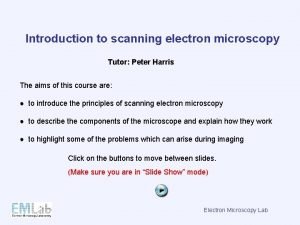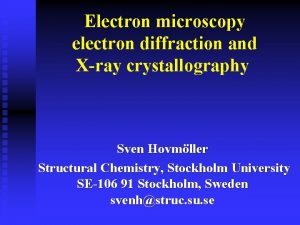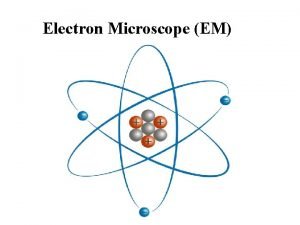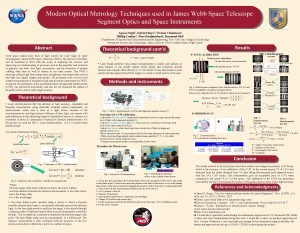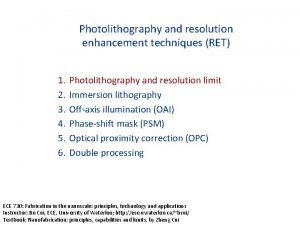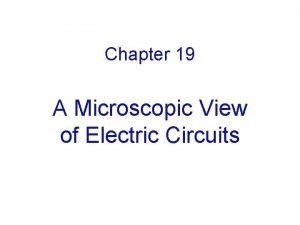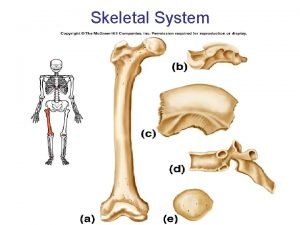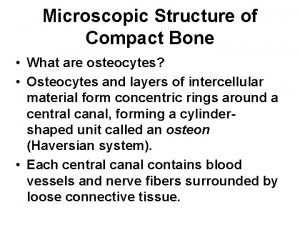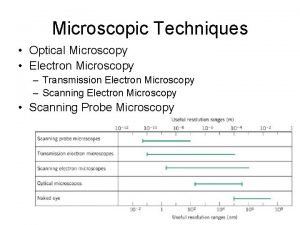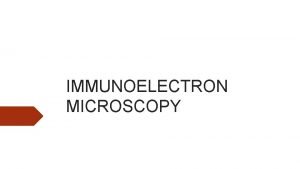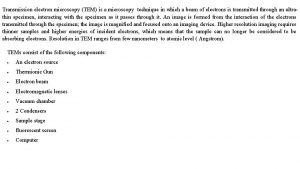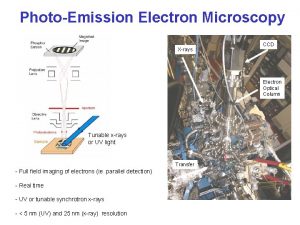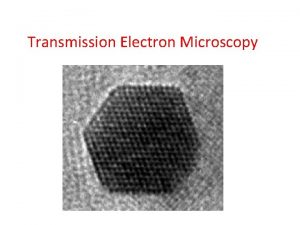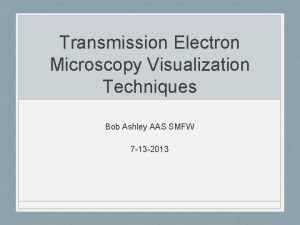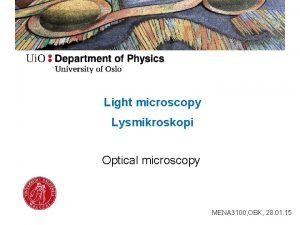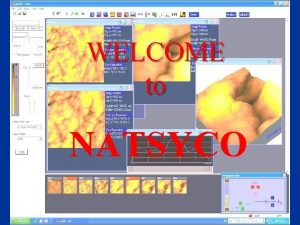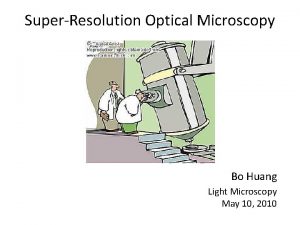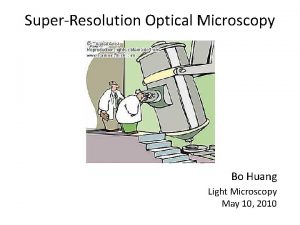Microscopic Techniques Optical Microscopy Electron Microscopy Transmission Electron
















- Slides: 16

Microscopic Techniques • Optical Microscopy • Electron Microscopy – Transmission Electron Microscopy – Scanning Electron Microscopy • Scanning Probe Microscopy

Optical Microscopy With optical microscopy, the light microscope is used to study the microstructure; optical and illumination systems are its basic elements. For materials that are opaque to visible light (all metals and many ceramics and polymers), only the surface is subject to observation, and the light microscope must be used in a reflecting mode. Contrasts in the image produced result from differences in reflectivity of the various regions of the microstructure. Investigations of this type are often termed metallographic, since metals were first examined using this technique.

Surface Preparation Normally, careful and meticulous surface preparations are necessary to reveal the important details of the microstructure. The specimen surface must first be ground and polished to a smooth and mirrorlike finish. This is accomplished by using successively finer abrasive papers and powders. The microstructure is revealed by a surface treatment using an appropriate chemical reagent in a procedure termed etching. The chemical reactivity of the grains of some single -phase materials depends on crystallographic orientation. Consequently, in a polycrystalline specimen, etching characteristics vary from grain to grain.

Figure 4. 13 b shows how normally incident light is reflected by three etched surface grains, each having a different orientation. Figure 4. 13 a depicts the surface structure as it might appear when viewed with the microscope; the luster or texture of each grain depends on its reflectance properties. A photomicrograph of a polycrystalline specimen exhibiting these characteristics is shown in Figure 4. 13 c.

Grain Boundary Grooves (a) Section of a grain boundary and its surface groove produced by etching; the light reflection characteristics in the vicinity of the groove are also shown. (b) Photomicrograph of the surface of a polished and etched polycrystalline specimen of an iron-chromium alloy in which the grain boundaries appear dark. 100×.

Electron Microscopy The upper limit to the magnification possible with an optical microscope is approximately 2000 times. Consequently, some structural elements are too fine or small to permit observation using optical microscopy. Under such circumstances the electron microscope, which is capable of much higher magnifications, may be employed. An image of the structure under investigation is formed using beams of electrons instead of light radiation. According to quantum mechanics, a high-velocity electron will become wave-like, having a wavelength that is inversely proportional to its velocity. When accelerated across large voltages, electrons can be made to have wavelengths on the order of 0. 003 nm (3 pm). High magnifications and resolving powers of these microscopes are consequences of the short wavelengths of electron beams. The electron beam is focused and the image formed with magnetic lenses; otherwise the geometry of the microscope components is essentially the same as with optical systems. Both transmission and reflection beam modes of operation are possible for electron microscopes.

Transmission Electron Microscopy The image seen with a transmission electron microscope (TEM) is formed by an electron beam that passes through the specimen. Details of internal microstructural features are accessible to observation; contrasts in the image are produced by differences in beam scattering or diffraction produced between various elements of the microstructure or defect. Since solid materials are highly absorptive to electron beams, a specimen to be examined must be prepared in the form of a very thin foil; this ensures transmission through the specimen of an appreciable fraction of the incident beam. The transmitted beam is projected onto a fluorescent screen or a photographic film so that the image may be viewed. Magnifications approaching 1, 000× are possible with transmission electron microscopy, which is frequently utilized in the study of dislocations.

Scanning Electron Microscopy A more recent and extremely useful investigative tool is the scanning electron microscope (SEM). The surface of a specimen to be examined is scanned with an electron beam, and the reflected (or back-scattered) beam of electrons is collected, then displayed at the same scanning rate on a cathode ray tube (similar to a CRT television screen). The image on the screen, which may be photographed, represents the surface features of the specimen. The surface may or may not be polished and etched, but it must be electrically conductive; a very thin metallic surface coating must be applied to nonconductive materials. Magnifications ranging from 10 to in excess of 50, 000 times are possible, as are also very great depths of field. Accessory equipment permits qualitative and semiquantitative analysis of the elemental composition of very localized surface areas.

Scanning Probe Microscopy In the past decade and a half, the field of microscopy has experienced a revolution with the development of a new family of scanning probe microscopes. This scanning probe microscope (SPM), of which there are several varieties, differs from the optical and electron microscopes in that neither light nor electrons is used to form an image. Rather, the microscope generates a topographical map, on an atomic scale, that is a representation of surface features and characteristics of the specimen being examined. Some of the features that differentiate the SPM from other microscopic techniques are as follows: Examination on the nanometer scale is possible inasmuch as magnifications as high as 109× are possible; much better resolutions are attainable than with other microscopic techniques. Three-dimensional magnified images are generated that provide topographical information about features of interest. Some SPMs may be operated in a variety of environments (e. g. , vacuum, air, liquid); thus, a particular specimen may be examined in its most suitable environment.

Scanning probe microscopes employ a tiny probe with a very sharp tip that is brought into very close proximity (i. e. , to within on the order of a nanometer) of the specimen surface. This probe is then raster-scanned across the plane of the surface. During scanning, the probe experiences deflections perpendicular to this plane, in response to electronic or other interactions between the probe and specimen surface. The in-surface-plane and out-of-plane motions of the probe are controlled by piezoelectric (Section 18. 25) ceramic components that have nanometer resolutions. Furthermore, these probe movements are monitored electronically, and transferred to and stored in a computer, which then generates the three-dimensional surface image. Specific scanning probe microscopic techniques differ from one another with regard to the type of interaction that is monitored. A scanning probe micrograph in which may be observed the atomic structure and a missing atom on the surface of silicon is shown in the chapter-opening photograph for this chapter. These new SPMs, which allow examination of the surface of materials at the atomic and molecular level, have provided a wealth of information about a host of materials, from integrated circuit chips to biological molecules. Indeed, the advent of the SPMs has helped to usher in the era of nanomaterials—materials whose properties are designed by engineering atomic and molecular structures.

Size ranges for several structural features found in materials

Useful resolution ranges for four microscopic techniques discussed in this chapter, in addition to the naked eye

Grain Size Determination The grain size is often determined when the properties of a polycrystalline material are under consideration. In this regard, there exist a number of techniques by which size is specified in terms of average grain volume, diameter, or area. Grain size may be estimated by using an intercept method, described as follows. Straight lines all the same length are drawn through several photomicrographs that show the grain structure. The grains intersected by each line segment are counted; the line length is then divided by an average of the number of grains intersected, taken over all the line segments. The average grain diameter is found by dividing this result by the linear magnification of the photomicrographs. Probably the most common method utilized, however, is that devised by the American Society for Testing and Materials (ASTM). 7 The ASTM has prepared several standard comparison charts, all having different average grain sizes. To each is assigned a number ranging from 1 to 10, which is termed the grain size number. A specimen must be properly prepared to reveal the grain structure, which is photographed at a magnification of 100×. Grain size is expressed as the grain size number of the chart that most nearly matches the grains in the micrograph. Thus, a relatively simple and convenient visual determination of grain size number is possible. Grain size number is used extensively in the specification of steels.

ASTM grain size number Let n represent the grain size number, and N the average number of grains per square inch at a magnification of 100×. These two parameters are related to each other through the expression:

Example Problem (a) Determine the ASTM grain size number of a metal specimen if 45 grains per square inch are measured at a magnification of 100×. (b) For this same specimen, how many grains per square inch will there be at a magnification of 85×?

IMPORTANT TERMS AND CONCEPTS Alloys Imperfections Screw dislocation Atom percent Interstitial Self-interstitial Atomic vibrations Microscopy Solid solution Boltzmann's constant Microstructure Solute Burgers vector Mixed dislocations Solvent Composition Photomicrograph Substitutional Dislocation line Point defects Transmission electron microscope (TEM) Edge dislocation Scanning electron microscope (SEM) Vacancy Grain size Scanning probe microscope (SPM) Weight percent
 Storage holds for future use
Storage holds for future use Microscopy tutor
Microscopy tutor Electron microscopy data bank
Electron microscopy data bank Bacteriorhodopsin
Bacteriorhodopsin Principle of tem
Principle of tem Optical metrology techniques
Optical metrology techniques Photolithography resolution
Photolithography resolution Microscopic examination of metals
Microscopic examination of metals Chemstix
Chemstix Pyuria leukocytes urine
Pyuria leukocytes urine Microscopic view of current
Microscopic view of current Diagram microscopic structure of bone
Diagram microscopic structure of bone Microscopic anatomy of compact bone
Microscopic anatomy of compact bone Direct microscopic count
Direct microscopic count Microscopic anatomy of skeletal muscle figure 6-2
Microscopic anatomy of skeletal muscle figure 6-2 Resistivity
Resistivity What does fatty diarrhea look like
What does fatty diarrhea look like

